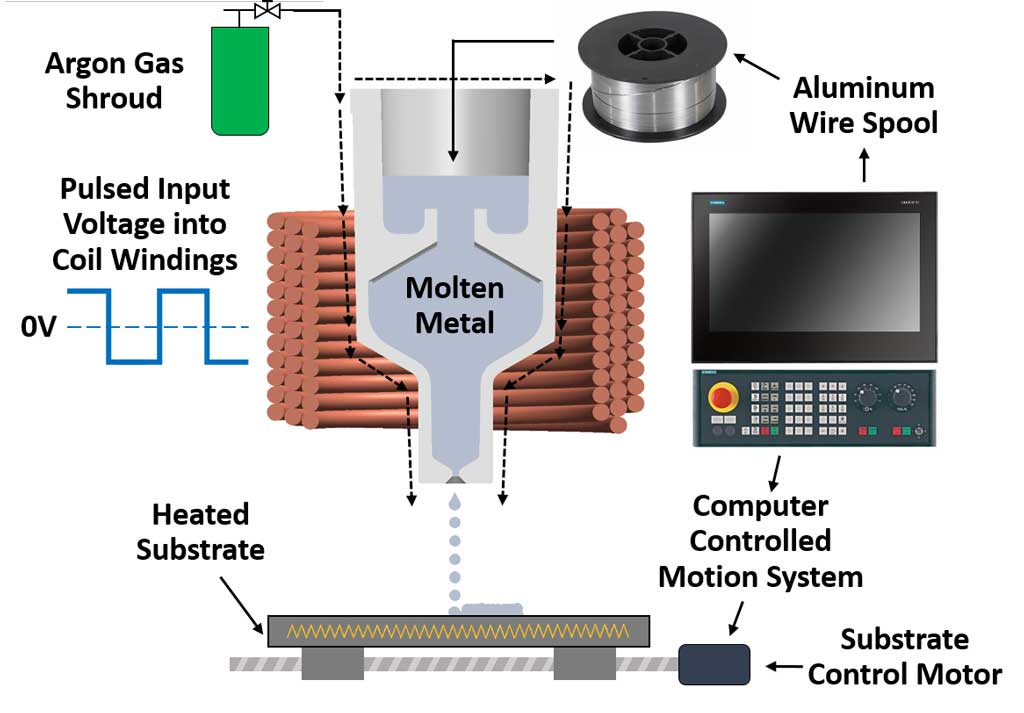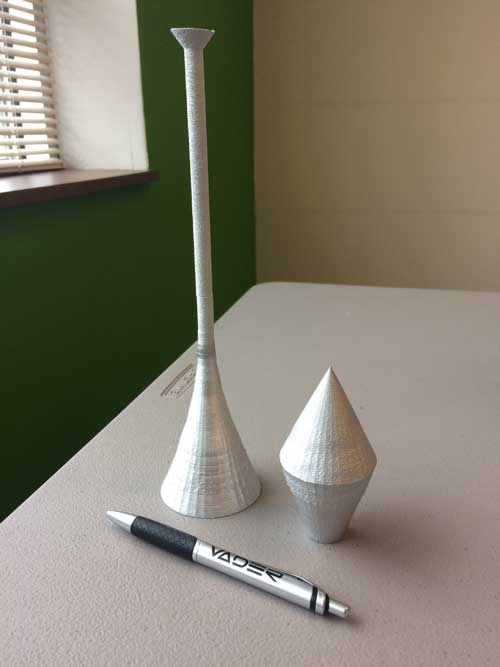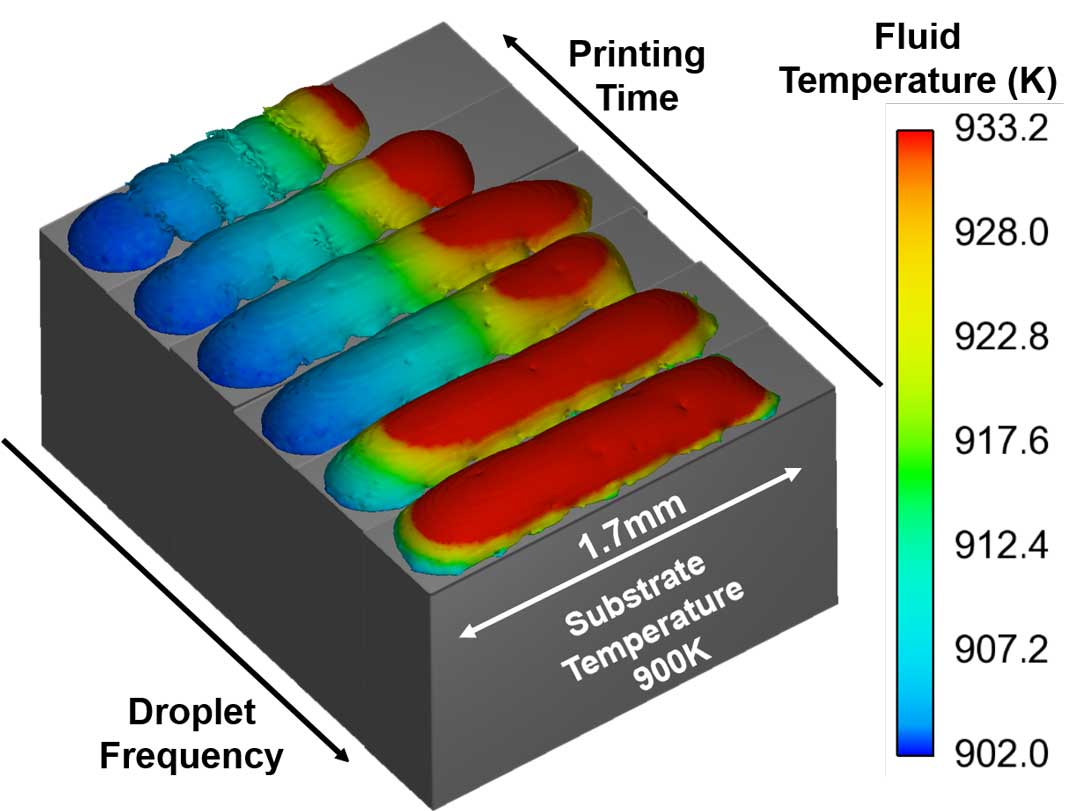Liquid Metal 3D Printing
This article was contributed by V. Sukhotskiy1,2, I. H. Karampelas3, G. Garg 1, A. Verma1, M. Tong 1, S. Vader2, Z. Vader2, and E. P. Furlani1
1University at Buffalo SUNY, 2Vader Systems, 3Flow Science, Inc.
Drop-on-demand inkjet printing is a well-established method for commercial and consumer image reproduction. The same principles that drive this technology can also be applied in the fields of functional printing and additive manufacturing. Conventional inkjet technology has been used to print a variety of functional media, tissues and devices by depositing and patterning materials that range from polymers to living cells [1, 2]. The focus of this work is on the extension of inkjet- based technology to the printing of 3D solid metal structures [3, 4]. Currently, most 3D metal printing applications involve deposited metal powder sintering or melting under the influence of an external directed energy source such as a laser [6] or an electron beam [7] to form solid objects. However, such methods have disadvantages in terms of cost and process complexity, e.g., the need for time and energy intensive techniques to create powder in advance of the 3D printing process.
In this article, we will discuss a novel approach to additive manufacturing of 3D metal structures based on magnetohydrodynamic (MHD) drop-on-demand ejection and liquid droplet deposition on a moving substrate. A number of simulations were performed to study each part of the process. For simplicity, the study was split into two parts: In the first part, an MHD analysis was used to estimate the pressure, generated by the Lorentz force density inside the printhead, which is then used as a boundary condition for a FLOW-3D model that was used to study the droplet ejection dynamics. In the second part, a FLOW-3D parametric analysis was performed in order to identify the ideal droplet deposition conditions. The results of the modeling effort were used to guide the design of the device, which is shown in Fig. 1. A coil surrounds the ejection chamber and is electrically pulsed to produce a transient magnetic field that permeates the liquid metal and induces a closed loop transient electric field within it. The electric field gives rise to a circulating current density, which back-couples to the transient field and creates a magentohydrodynamic Lorentz force density within the chamber. The radial component of the force creates a pressure that acts to eject a liquid metal droplet out of the orifice. Ejected droplets travel to a substrate where they coalesce and solidify to form extended solid structures. Three-dimensional structures of arbitrary shape can be printed layer-by-layer using a moving substrate that enables precise patterned deposition of the incident droplets. This technology has been patented and commercialized by Vader Systems (www.vadersystems.com) under the tradename MagnetoJet.
Advantages of the MagnetoJet printing process include the printing of 3D metallic structures of arbitrary shape at relatively high deposition rates and with low material costs [8, 9]. In addition, the presence of unique metallic grain structures suggests the ability to print parts with improved mechanical properties [9].
Prototype Device Development
A key component of Vader Systems’ 3D printing system is a printhead assembly composed of a two-part nozzle, and a solenoidal coil. Liquefication occurs in the top part of the nozzle. The lower part contains a submillimeter orifice, which can range from 100µm to 500µm in diameter. The water cooled solenoidal coil surrounds the orifice chamber as shown in Fig. 1a (cooling system not shown). The iterative development of numerous printhead designs has been pursued to explore the effects of ejection chamber geometry on the liquid metal filling behavior as well as droplet ejection dynamics. These prototype systems have successfully printed solid 3D structures made from common aluminum alloys (Fig. 2). Droplets range from 50 μm to 500 μm in diameter depending on the orifice diameter, geometry, ejection frequency and other parameters. Sustained droplet ejection rates from 40-1000 Hz with short bursts up to 5000 Hz have been achieved.
Computational Models
As part of the prototype device development, computational simulations were performed in advance of prototype fabrication to screen design concepts for performance i.e., droplet ejection dynamics, droplet-air and droplet-substrate interactions. In order to simplify the analysis, two different complimentary models were developed that used computational electromagnetic (CE) as well as CFD analysis. In the first model, a two-step CE and CFD analysis was used to study MHD-based droplet ejection behavior and effective pressure generation. In the second model, thermo-fluidic CFD analysis was employed to study the patterning, coalescence and solidification of droplets on the substrate.
Following the MHD analysis, an equivalent pressure profile was extracted from the first model and used as input for the FLOW-3Dmodel, designed to explore the transient dynamics of droplet ejection and droplet-substrate interactions. FLOW-3D simulations were performed to understand the effects of wetting in and around the orifice on droplet ejection. By varying the fluid initialization level, both inside and outside the orifice and allowing for a time period between pulses as determined by the pulsing frequency, we were able to identify differences in the characteristics of the ejected droplets including size and velocity.
Droplet Generation
In the MagnetoJet printing process, droplets are ejected with a velocity that typically ranges from 1-10 m/s depending on the voltage pulse parameters, and cool slightly during flight before impacting the substrate. The ability to control the patterning and solidification of droplets on the substrate is critical to the formation of precise 3D solid structures. Accurate droplet placement for patterning is achieved using a high resolution 3D motion base. However, controlling solidification to create well-formed 3D structures with low porosity and without undesired layering artifacts is a challenge as it involves the control of:- thermal diffusion from the droplet to the surrounding materials as it cools,
- the size of the ejected droplet,
- the droplet ejection frequency and
- thermal diffusion from the already formed 3D object.
Droplet Coalescence and Solidification
We investigated intralayer droplet coalescence and solidification on a heated substrate as a function of the center-to-center spacing between droplets as well as the droplet ejection frequency. In this analysis, spherical droplets of liquid aluminum impact a heated stainless steel substrate from a height of 3 mm. The droplets have an initial temperature of 973 K and the substrate is held at 900 K, slightly below the solidification temperature of 943 K. Figure 3 shows droplet coalescence and solidification during the printing of a solid line when the droplet separation distance is varied from 100 μm to 400 μm in steps of 50 μm, with the ejection frequency held constant at 500 Hz. When the droplet separation exceeds 250 µm, solidified segments with cusps appear along the line. At a separation distance of 350 μm or greater, the segments become discrete and the line has unfilled gaps, which is undesired for the formation of smooth solid structures. We performed a similar analysis for substrates held at lower temperatures, e.g. 600 K, 700 K etc. It was observed that while 3D structures can be printed on cooler substrates, they show undesirable artifacts such as lack of strong coalescence between subsequent layers of deposited metal . This is due to the increased rate of loss of thermal energy in the deposited droplets. The ultimate choice of substrate temperature can be determined based on an acceptable print quality of an object for a given application. This can even be done dynamically to adjust for the higher thermal diffusion as the part becomes larger during printing.
Validation of FLOW-3D Results
Figure 4 shows a cup structure printed on a heated substrate. During the printing process, the temperature of the heated substrate was increased gradually from 733K (430°C) to 833K (580°C) in real time based on the instantaneous height of the printed part. This was done to overcome the increase of local thermal diffusion as the object surface area increases. The high thermal conductivity of aluminum makes this especially difficult, since any adjustment to the local thermal gradient has to be made quickly, otherwise the temperature will decrease quickly and degrade the intralayer coalescence.Conclusion
Based on the simulation results, Vader System’s prototype magnetohydrodynamic liquid metal drop-on-demand 3D printer prototype was capable of printing 3D solid aluminum structures of arbitrary shape. These structures were successfully printed using layer-by-layer patterned deposition of submillimeter droplets. Material deposition rates of over 540 grams per hour were achieved using only one nozzle. The commercialization of this technology is well underway but challenges remain in realizing optimum printing performance in terms of throughput, efficiency, resolution and material selection. Further modelling work will focus on quantifying transient thermal effects during the printing process, meniscus behavior as well as evaluate the quality of the printed parts.
References
[1] Roth, E.A., Xu, T., Das, M., Gregory, C., Hickman, J.J. and Boland, T., “Inkjet printing for high-throughput cell patterning,” Biomaterials 25(17), 3707-3715 (2004).
[2] Sirringhaus, H., Kawase, T., Friend, R.H., Shimoda, T., Inbasekaran, M., Wu, W. and Woo, E.P., “High-resolution inkjet printing of all-polymer transistor circuits,” Science 290(5499), 2123-2126 (2000).
[3] Tseng, A.A., Lee, M.H. and Zhao, B., “Design and operation of a droplet deposition system for freeform fabrication of metal parts,” Transactions-American Society of Mechanical Engineers Journal of Engineering Materials and Technology 123(1), 74-84 (2001).
[4] Suter, M., Weingärtner, E. and Wegener, K., “MHD printhead for additive manufacturing of metals,” Procedia CIRP 2, 102-106 (2012).
[5] Loh, L.E., Chua, C.K., Yeong, W.Y., Song, J., Mapar, M., Sing, S.L., Liu, Z.H. and Zhang, D.Q., “Numerical investigation and an effective modelling on the Selective Laser Melting (SLM) process with aluminium alloy 6061,” International Journal of Heat and Mass Transfer 80, 288-300 (2015).
[6] Simchi, A., “Direct laser sintering of metal powders: Mechanism, kinetics and microstructural features,” Materials Science and Engineering: A 428(1), 148-158 (2006).
[7] Murr, L.E., Gaytan, S.M., Ramirez, D.A., Martinez, E., Hernandez, J., Amato, K.N., Shindo, P.W., Medina, F.R. and Wicker, R.B., “Metal fabrication by additive manufacturing using laser and electron beam melting technologies,” Journal of Materials Science & Technology, 28(1), 1-14 (2012).
[8] J. Jang and S. S. Lee, “Theoretical and experimental study of MHD (magnetohydrodynamic) micropump,” Sensors & Actuators: A. Physical, 80(1), 84-89 (2000).
[9] M. Orme and R. F. Smith, “Enhanced aluminum properties by means of precise droplet deposition,” Journal of Manufacturing Science and Engineering, Transactions of the ASME, 122(3), 484-493, (2000)




